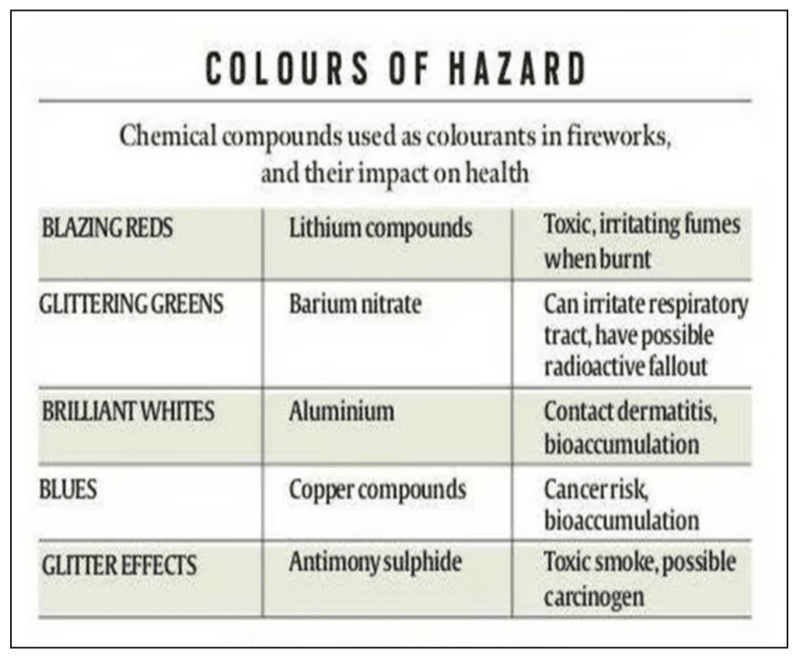News Excerpt:
The Supreme Court clarified that its order banning the use of barium and other banned chemicals in firecrackers applies to the entire country and not just the National Capital Region.
- A bench of Justices A S Bopanna and M M Sundresh was hearing an application that sought directions to the Rajasthan government to comply with the top court’s orders.
- The said orders will bind every state in the country, including Rajasthan.
What are the SC orders on firecrackers?
- In October 2018, the Apex court banned producing and selling all crackers except ‘green crackers’ and those with reduced emissions (improved crackers).
- It also banned the manufacture and sale of ‘joined crackers’ (long rows of crackers joined together), prohibited barium salts in fireworks and said their noise levels should be within permissible limits.
- The court reiterated this in its October 29, 2021 order.
- In 2020, the National Green Tribunal banned the sale and use of all kinds of firecrackers in NCR and said that green crackers would be permitted only in cities and towns with moderate or poor air quality.
Constitutional Provisions:
- (Fundamental Right)Article 21: The right to live is a fundamental right under Article 21 of the Constitution, and it includes the right to enjoy pollution-free water and air for the full enjoyment of life.
- (DPSP)Article 48A: The State shall endeavour to protect and improve the environment and safeguard the country's forests and wildlife. The 42nd Amendment added this Article in 1976 and obligated the state to protect the environment and wildlife.
- Article 51A(g): It shall be the obligation of every citizen of India to safeguard and develop the natural environment, including forests, lakes, rivers, and animals, and to have compassion for living beings.
What is a firecracker made of?
- Firecrackers typically contain four primary ingredients - oxidiser, fuel, colouring agents, and binder.
- An oxidiser is required for the cracker to catch fire.
- The fuel sustains the fire; colouring agents give it the colours and sparkles.
- The binder holds this mixture in place till the cracker has spent itself.
- Chemicals like barium are colouring agents and were banned because of their harmful impact on human health, such as irritation in the respiratory tract, skin allergies, breathing difficulties, and even cancer.

Colour in Crackers:
- The white colour in a cracker is emitted through aluminium, magnesium and titanium.
- The orange colour is carbon or iron.
- Yellow agents are sodium compounds.
- Blue and red are copper compounds and strontium carbonates.
- The green agent is barium monochloride salts, barium nitrate, or barium chlorate.
What are Green crackers?
-
Green crackers are so named because they “do not contain harmful chemicals” that would cause air pollution.
-
Components in firecrackers are replaced with others that are “less dangerous” and “less harmful” to the atmosphere.
-
These crackers emit less harmful chemicals and release water vapour, a dust suppressant.
The three broad categories of Green crackers are SWAS, SAFAL, and STAR, which CSIR developed.
- SWAS stands for “safe water releaser”, and has a small water pocket that is released in the form of vapour when the cracker is burst. This suppresses dust.
- STAR, or safe thermite cracker, does not comprise potassium nitrate and sulphur, and emits reduced particulate matter at reduced sound intensity.
- SAFAL is safe minimal aluminium, which has minimum usage of aluminium, and used magnesium instead. This too emits less noise than traditional crackers.
Mains PYQ
Q. Does the right to clean environment entail legal regulation on burning crackers during Diwali? Discus in the light of Article 21 of Indian Constitution and judgements of the apex in this regard. (UPSC 2015)


